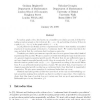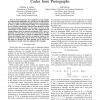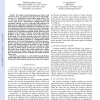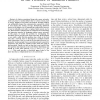43 search results - page 7 / 9 » Percolation in the Secrecy Graph |
RSA
2010
13 years 5 months ago
2010
A random graph order, also known as a transitive percolation process, is defined by taking a random graph on the vertex set {0, . . . , n − 1}, and putting i below j if there i...
CORR
2010
Springer
13 years 4 months ago
2010
Springer
Nested codes have been employed in a large number of communication applications as a specific case of superposition codes, for example to implement binning schemes in the presence ...
CORR
2010
Springer
13 years 7 months ago
2010
Springer
: We consider a class of point processes, which we call sub-Poisson; these are point processes that can be directionallyconvexly (dcx) dominated by some Poisson point process. The ...
SLS
2009
Springer
14 years 1 months ago
2009
Springer
Stochastic local search algorithms can now successfully solve MAXSAT problems with thousands of variables or more. A key to this success is how effectively the search can navigate...
ICC
2008
IEEE
14 years 1 months ago
2008
IEEE
—In battery-constrained large-scale sensor networks, nodes are prone to random failures due to various reasons, such as energy depletion and hostile environment. Random failures ...




